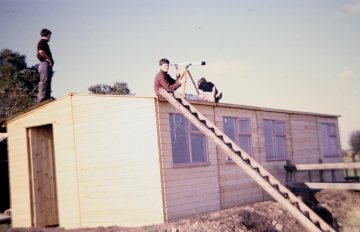All three, along with myself, were members of Romford Ringing Station, based at Breton's Farm (which is now a sports complex), and it was through them that we were introduced to Bradwell Bird Observatory, a place I still visit at least once a month 45 years on!
It was wild in those days - or wilder than it seems now, although the Dengie coast remains - along with Hamford Water - one of the most remote and inaccessible stretches of the Essex coast. In a past era this shore was the haunt of dozens of professional wildfowlers (or Marsh Men as they were then known) who made a living from shooting wildfowl and waders, fishing, ‘cockling’, and harvesting Marsh Samphire and other products of the estuary. One such was Walter Linnet, who lived in the tiny cottage mentioned above (now named after him) on the edge of the saltmarsh overlooking the Blackwater Estuary. The cottage was built around 1798 by the Admiralty in order to house two naval officers - a lieutenant and a midshipman – whose job it was, along with two ordinary seamen, to man a signalling station on high ground nearby. The boredom engendered by the site’s isolation, coupled with having to live cheek by jowl in cold cramped quarters, not to mention the ever present threat of being laid low by the dreaded Essex ague (a form of malaria) must have made this the posting from hell. A surviving letter from November 1810 written by one Lieutenant John Leckie to their Lordships about the midshipman under his command states that:
“…….he went from the station without asking leave and stayd all night, did not return until nine this Next morning, and was then obliged to go to bed; I talked to him on that business, and he told me that he did not know that he was supposed to ask leave but promised to do so no more, on Thursday last he asked leave to go up to the village which he did, on the next morning he asked leave again which I granted him, and last evening he went away again without leave, and did not return again until one past ten, this forenoon and so drunk, that he went to bed immediately, he is without exception the most stupid man I ever had or saw……..â€*
Winters must have been fun in such company! At the end of the Napoleonic wars the signal station was closed down. The Linnet family are thought to have taken up residence in the middle of the century and remained in occupation until 1958 when the last member of their family to live there, Walter Linnett, died at the age of 80. He and his wife raised eight children there and it is rumoured that the babes in arms were put to bed in boxes in the cupboards. From the moment they could toddle much of their lives would have been spent out of doors. Walter’s father is likely to have been among the thirty-two punt gunners who are reputed to have fired simultaneously into a flock of Brent Geese on the Dengie flats in around 1860, killing at least 704 of them. Several other huge bags of geese were also reported from the area at around this time. The same era saw over 3000 Lapwing eggs sent to market one summer from a single Norfolk estate alone, not just the original clutch of each pair being taken but all the replacement clutches as well. They weren’t into sustainability at that time either!
Eleven years after this photo was taken the Bradwell hut was flooded twice in one year, as a consequence of which it was moved to slightly higher ground nearby soon afterwards. The first time it happened I arrived in the village on the 10pm bus (!) one Friday evening and walked the two and a half miles to the hut in the dark. On arrival I found that the tide had come and gone, leaving a high water mark at around the two foot level on the walls. Among the debris attached to it were five species of seaweed while I identified the remains of a dozen different types of shellfish embalmed in the two inches of estuarine mud that covered the floor. The rest of that evening was spent on my hands and knees attempting to soak up the liquid ooze using old, torn up blankets from the bunks. After a few hours I succeeded in transferring most of it from the floor into buckets and from there back to the saltings from whence it came but by this time both my trousers and sweatshirt were virtually indistinguishable from the blankets used to mop up the mud. Needing a cuppa, I pulled an easy chair close to the decrepit paraffin heater which was our only means of heating the hut but within minutes found myself enveloped in huge clouds of steam! It was a bitterly cold night so I decided to sleep in front of the fire; not a wise decision as after several hours of breathing in paraffin fumes I awoke with the mother of all hangovers and spent the next few hours with my head over the sink. Happy days!
The old site has not been flooded since! We have also acquired a Carbon monoxide monitor!
*Thanks are due to Kevin Bruce, local historian, for these details.


















